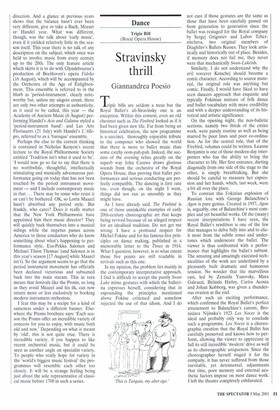Dance
Triple Bill (Royal Opera House)
Stravinsky
thrill
Giannandrea Poesio
Triple bills are seldom a treat but the Royal Ballet's all-Stravinsky one is an exception. Within this context, even an old chestnut such as The Firebird looked as if it had been given new life. Far from being an historical celebration, the new programme is a succinct, thoroughly enjoyable tribute to the composer who showed the world that there is more to ballet music than some catchy oom-pah-pah. Indeed, the success of the evening relies greatly on the superb way John Carewe draws glorious sounds from the orchestra of the Royal Opera House, thus proving that ballet performances and serious conducting are perfectly compatible. The dancing is first rate too, even though, on the night I went, things did not run as smoothly as they might have.
As I have already said, The Firebird is one of those unsinkable examples of early 20th-century choreographic art that keeps being revived because of an alleged respect for an idealised tradition. Do not get me wrong: I have a profound respect for Michel Fokine and for his famous five principles on dance making, published in a memorable letter to the Times in 1914. What I question, however: is to what extent those five points are still readable in revivals such as this one.
In my opinion, the problem lies mainly in the contemporary interpretative approach. I find it difficult to accept the purely Swan Lake mime gestures with which the ballerina expresses herself, considering that in expounding the principles mentioned above Fokine criticised and somehow rejected the use of that idiom. And I do
not care if those gestures are the same as those that have been carefully passed on from generation to generation since the ballet was restaged for the Royal company by Sergej Grigoriev and Lubov Tchernitcheva, two original members of Diaghilev's Ballets Russes. They look artistically and historically out of place. Besides, if memory does not fail me, they never were that mechanically Swan-Lakeish.
Similarly, I do not understand why the evil sorcerer Kotschej should become a comic character. According to source material, the original role was anything but comic. Finally, I would have liked to have seen dancers approach that exquisite and typically Fokinian mixture of folk dance and ballet vocabulary with more credibility and with a deeper understanding of its historical and artistic significance.
On the opening night, the non-balletic sections, namely two thirds of the entire work, were purely routine as well as being marred by poor lines and poor co-ordination. As for the central role, that of the Firebird, volumes could be written. Leanne Benjamin is one of those modem-day interpreters who has the ability to bring the character to life. Her first entrance, darting diagonally from one side of the stage to the other, is simply breathtaking. But she should be careful to measure her expression and her hands, which, last week, were a bit all over the place.
To contrast this Fokinian explosion of Russian lore with George Balanchine's Agon is pure genius. Created in 1957, Agon is, arguably, one of Balanchine's most complex and yet beautiful works. Of the (many) recent interpretations I have seen, the Royal Ballet's rendition is one of the few that manages to delve fully into and to elicit most from the subtle tones and undertones which underscore the ballet. The viewer is thus confronted with a performance that highlights the ballet's subtext. The amazing and amazingly executed technicalities of the work are underlined by a pleasantly built dramatic and humorous tension. No wonder that the marvellous cast, led by Zenaida Yanovsky, Mara Galeazzi, Belinda Hatiey, Carlos Acosta and Johan Kobborg, was given a thunderous ovation at the end.
After such an exciting performance, which confirmed the Royal Ballet's perfect attunement to Balanchine's canons, Bronislava Nijinska's 1923 Les Noces is the ideal and probably only way to conclude such a programme. Les Noces is a choreographic creation that the Royal Ballet has carefully preserved and knows how to perform, allowing the viewer to appreciate in full its still incredible 'modern' drive as well as its choreographic uniqueness. Since the choreographer herself staged it for the company, it has never suffered from those inevitable, yet detrimental, adjustments that time, poor memory and external aesthetic factors impose on most dance work. I left the theatre completely exhilarated.










































































 Previous page
Previous page